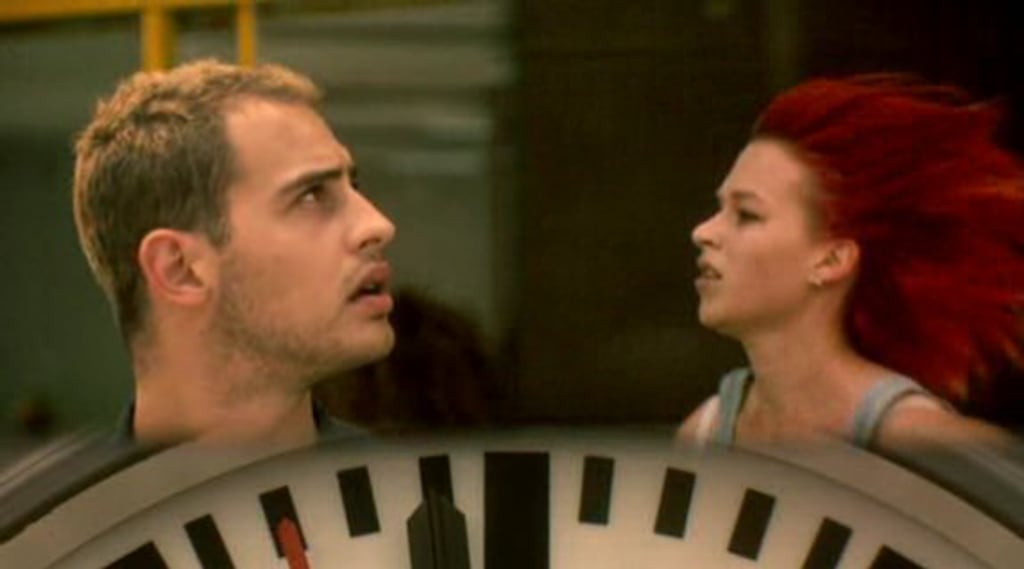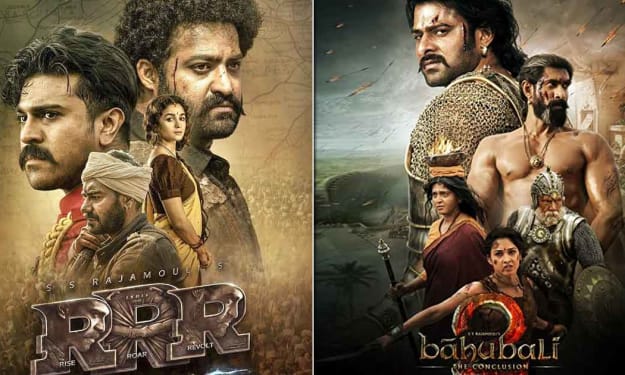Analysis of Lola Rennt ('Run Lola Run')
An essay on how this iconic German film has links to video games using its many elements.

Lola Rennt in Run Lola Run (Tom Tykwer, 1998) is an ‘experimental’ crime, drama and action film, which Tykwer said was “going to be an experimental film for a mass audience” (McCarthy & Halle, 2003, 401). The film’s post-modern narrative begins when Manni, Lola’s boyfriend, loses a bag containing 100,000 Marks that was meant to be delivered to a crime boss on a Berlin subway train, which is then stolen by a homeless man. Lola has 20 minutes to obtain 100,000 Marks, or her boyfriend will be killed for his blunder.
Lola experiences these 20 minutes three different times, all of which result in different endings until Lola can put their world right again. The extract is between the second and third versions of these ‘runs,’ which show interesting details in the film that suggests the world the film takes place in is actually a video game, specifically a multiple choice video game, which allows the player to choose their actions, which affects the overall story, such as the game Heavy Rain (2010).
The narrative of Lola Rennt is non-linear, and does not occur in chronological order. Instead as mentioned prior, it involves the same 20 minutes, and it occurs three times. Each time the 20-minute time frame includes the same goal, the same challenges, however different outcomes in these challenges, and an overall result change in a run. For example, at the beginning of the extract, Lola is robbing her father’s bank for the 100,000 Marks in this run after being denied it when asking for his help, and she finds out he had been seeing another woman. In the first run, Lola was kicked out of the bank by her father, and it was revealed that she was not his biological child, and that he had been seeing another woman; however, she did not rob him in this run. In the third run, Lola’s father had left the bank before she could arrive there. This is just one aspect of the 20-minute cycle that keeps reoccurring as a challenge. There is also the glass wall, the ambulance, the boy and the dog, and more. This plot technique is commonly described as a ‘time lock’ or a ‘story deadline’ that is used to create suspense in the narrative (Nelmes, 2012, 108) and “propels the film forward” (McCarthy & Halle, 2003, 407). This suggests that the film is an interpretation of a video game, because of its non-linear narrative. When a player fails a task in a video game, often they would have to replay the level from the beginning. This is precisely what we see in the film. Lola robbing the bank is another attempt, another path of a multiple choice game to try and beat the ‘level’. However, later in the extract, it is discovered that the path Lola chose in her second run was also a failure, prompting the start of the third run.
The shot towards the end of the second ‘run’ is a split screen formed of close-ups of three critical entities within the film. These are Manni, Lola, and a clock, which represents time.

Firstly, it uses the composition of the framed shot to show the emphasis of getting from ‘A’ to ‘B’ (Lola at home to Manni with 100,00 Marks) in a specific time frame, seconds before the clock strikes noon. This adds to the thesis of the film being an interpretation of a video game as many video games in the past have used these devices to form a challenge similar to what Lola faces. They are commonly known as ‘time trials’ or ‘speed runs’. For example, the game Super Mario Bros. (1983) is a platformer game which requires the main character, Mario, to run from one place to another in the shortest time possible, and is merely one game of this common video game genre. Their ‘proximity and proportion’ are significant to the composition as it indicates that they are essential to the film (Monaco, 2000, 188), because the composition makes the characters isolated.
Secondly, this shot uses depth of field to blur the background of the protagonists to create a shot where only Lola, Manni, and the clock can be viewed clearly by the audience, making everything else behind them obsolete. This is significant because it isolates and draws the audience to them, similar to how the end of a quest or a ‘goal’ would draw the player to it in a video game. In the game Super Mario Galaxy (2007), the levels often included significant features to goals, so they could be identified by the player, allowing them to know exactly where to go. For example, the goals in the game are presented in the form of ‘stars’, which in certain levels, feature a light source to indicate where they are in the game map.
At the end of the second run, Manni dies when he is run over by the ambulance. The camera slowly zooms in on Manni's face as a fade to red effect is used to transition us to the next scene, which suggests the scene is occurring in his dying mind. The scene is between Lola and Manni, and it's tinted continuously with a red colour.

The colour used in this scene is red, the colour of blood. This adds to the thesis of the film being an interpretation of a video game, as in the past, particularly in mature games where blood can be shown, a blood red ‘game over’ screen is shown when the player fails a task or ‘mission,’ because of a death. In the film, Manni has died, and Lola’s mission to save him has failed. The connotations between the colour red, the scene, and death also support this. An example of this is in Grand Theft Auto V (2013) as if your character or others die in gameplay, you are presented with a ‘wasted’ or ‘mission failed’ screen in bold red letters, and a grey lifeless tinted background.
Alternatively, the scene can be interpreted as a ‘game over’ cut-scene, something presented to players in a video game when they have failed a task that can be used to show a player an outcome, give information on a story, or encourage them to keep playing for another attempt. The performance of the characters is used cleverly in this scene. Lola and Manni are interacting with each other, talking about a delicate topic, and are intimate, and doubtful of themselves and their relationship. This is seen in both of the ‘red’ scenes in the film, and it is clear that these scenes focus on their “romantic anxieties” (Bergfelder, Carter, & Göktürk, 2002, 206). In the scene, Manni asks what Lola would do if he died, and is concerned that if he did, Lola would move on after a short time, forgetting him, and leaving him and his memory behind. Lola is very passionate about Manni, and his doubt would want to make Lola prove her love for him, to keep ‘playing’ the same 20 minutes until she gets it right. As a cut-scene, this emotionally provocative interaction would encourage a player to ‘retry,’ and have another attempt to succeed. When the scene ends, this is exactly what Lola does as she begins the third attempt of her mission, appearing back at her house and running once more. An example of an emotional ‘game over’ cut-scene using characters’ performance is the Ninja Gaiden (1988) arcade game, which shows a Ninja tied down with a saw blade about to cut into their chest. The Ninja is animated to show his emotions of horror and dread to encourage the player to pay more money to keep playing, and have another attempt to win, so the Ninja’s death is avoided.
At the beginning of the 3rd run, Lola enters an animated scene where she can be seen running down an almost endless flight of stairs, avoiding obstacles on the flight of stairs to reach the bottom. This animated scene occurs once at the beginning of all three runs.

Firstly, this scene is entirely animated, while other scenes in the film apart from the animated introduction are ‘live action’. This brings the setting of the film into the discussion. This is significant as it suggests that Lola Rennt lives in a fictional world, which is not our own, and possibilities are different because Lola can go between 2D and 3D plains within the same world. She can morph and migrate into an animated cartoon and become ‘real’ at will effortlessly (Bergfelder, Carter, & Göktürk, 2002, 209). This solidifies the theory that she is a fictional cartoon, and imaginary. Clearly, the plains are linked to each other. The animated version of Lola in this scene has an impact on what happens in the live action scenes as the obstacle, the boy and the dog, have an impact on what happens to Lola. For example, during the second run, the boy trips Lola up and causes her to fall down the stairs. As a result, in the next live action scene, Lola limps because of her injury, and is slower because of it, affecting the rest of the run. This is also an example of 'cause and effect’ occurring within the film’s narrative. As the boy trips Lola in the second run, she is slower, however in the third run seen in the extract, she jumps over the boy and the dog, and in theory, should be faster (Nelmes, 2012, 108-109). It supports the idea that these worlds are linked and fictional, allowing it to be entirely possible that the world is part of a video game.
Secondly, this scene brings the setting into the discussion concerning the thesis of a ‘game world’ as there are obstacles that Lola must try and avoid as she progresses down the staircase. The boy and the dog are obstacles to Lola that she must defeat to progress the ‘level’ in the best way, and if she does not, the time it takes for her to succeed will increase, and a higher risk of failure is created. Lola faces obstacles throughout the film in this setting of a modern-day Berlin, may they be characters such as her father, the setting, or the mise-en-sene. Because the film is placed in a fictional world (indicated by the cartoon scene), “any game can be won, [and] any obstacles overcome” (Mueller, 2004, 170). The obstacles are commonly known as ‘enemies’ in video games, and almost every video game has them. As Lola runs in one forward direction, and encounters enemies along the way while running on challenging ground, this scene and the runs are comparable to the classic platformer games such as Sonic the Hedgehog (1991) and Donkey Kong (1981).
The music in the film (which is non-diegetic) is also used in a way that supports the thesis of the film being an interpretation of a video game, as it works with the emphasis of time the film has in relation to the ‘time trial’ or ‘speed run’ aspect of video games it represents through setting and atmosphere. The techno music that is present throughout the film as Lola runs ‘energizes the visuals’ (Mueller, 2004, 169), and emphasises the pressure she is facing, and the almost impossible challenge that she is trying to overcome in such a small amount of time. The pacing of the music is quite fast and fitting as she is constantly running, or under pressure when the audience hears it. It helps to set an atmosphere for the film, which the techno nature of the music provides. Video games have used music to create atmospheres in the same way film has since the coming of sound in film for decades, and is used in this way in almost every video game release today. It is an effective way to create mood and tension, and emphasize something. Yoshi’s Story (1998) used music in its levels to set an atmosphere. In the game’s first level, the music is calming and peaceful as the level takes place in a peaceful place. However, when fighting a villain, the music is frightening and dramatic, helping to create an atmosphere as such.
In conclusion, it is clear that many elements of the film, both visual and audio, can be interpreted in a way which suggests that Run Lola Run is an interpretation of a video game, because of its narrative, cinematography, character performance, and music. It is outstanding how many comparisons there are between the film and common elements used in video games before and after the film’s release, but as Ganesan said; “The ball is round, and the movie lasts 81 minutes. Anything else is merely hypothetical” (Ganesan, 2016).
Bibliography
Ganesan, P. (2016) Chance, Chaos and Coincidence, California: Stanford University.
Garwood, I. ‘The "Autorenfilm" in Contemporary German Cinema,' in Bergfelder T., Carter E. & Göktürk D. (eds.) (2002) The German Cinema Book, London: BFI, 202-210.
Kosta, B. “Tom Tykwer’s Run Lola Run and the Usual Suspects: The Avant-Garde, Popular Culture, and History” in Mueller, A. (ed.) (2004) German Pop Culture: How American Is It?, Michigan: University of Michigan Press, 165-179.
Lola Rennt (1998) Tom Tykwer [Film]. Germany: X-Filme Creative Pool.
McCarthy, M. & Halle, R. (eds.) (2003) Light Motives: German Popular Cinema in Perspective, Detroit: Wayne State University Press.
Monaco, J. (2000, 3rd edition) How to Read a Film: Movies, Media, Multimedia, Oxford: Oxford University Press.
Speidel, S. ”Postmodernism and playing games in Run Lola, Run”’ in Nelmes, J. (ed.) (2012; 5th edition) Introduction to Film Studies, London: Routledge, 107-10.
Author's Note
Thanks for reading the essay. This was my first essay for a university assignment. It was graded at 2:1, so I'm pretty happy with it for a first attempt.
About the Creator
Nathan Allan
A student at the University of Sunderland studying film and media. I'm interested in a whole lot of things. I'd appreciate it if you stick around and read some of my articles on a variety of things!






Comments
There are no comments for this story
Be the first to respond and start the conversation.